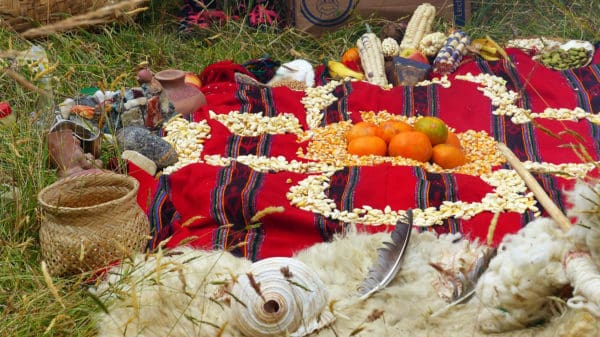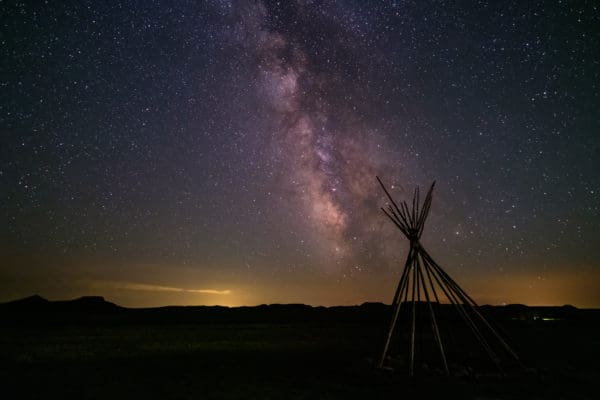The Wixárika, also known as Huichol, are an indigenous people that inhabit certain regions of the Western Sierra Madre in central Mexico. Admired around the world for their superb artisanry, the Wixárika are also known because of the strong cultural and spiritual traditions that they maintain, including the annual pilgrimage to their spiritual homeland of Wirikuta where they harvest the peyote cactus used sacramentally in their religious rites. As the psychoactive peyote plant has become more sought after by those around the world interested in experiencing the visionary state it induces, the entire cultural heritage of the Wixárika is in peril due to over-harvesting and the commodification of the cactus.
Wixárika Cosmology
The cosmology of the Wixárika is rooted in the confrontational dynamic expressed by the oppositional forces of the underworld and the heavens. The underworld is associated with feminine deities such as Takutsi Nakawe, Grandmother Earth, and the heavens are associated with masculine deities such as Tawewiekame, Father Sun. The significance of the Wixárika deities is tied to the role that each of them plays in the cultural framework that organizes their lives. As anthropologist Arturo Gutierrez del Angel states, “The ritual practices of the Huichol and in particular their pilgrimage is intimately tied to the way in which they contemplate the world and existence, their outlook and understanding of their cosmos, that is, their cosmovision.” This cosmovision defines their place in the greater unfolding of the universe, and it informs diverse aspects of their lives encompassing their agriculture, politics, and economy.
Pilgrimage to Wirikuta
The pilgrimage that the Wixárika undertake annually is a representation of the complex mythologies and symbologies that permeate their rich culture. The journey is one that reinstates the individual’s ties to the community and encourages personal transformation, but it also functions as a reenactment of the mythology that is the foundation of the Wixárika culture. The pilgrims destination is Wirikuta, the place believed to be where the sun first emerged and where their ancestors first picked peyote, which they refer to as Hikuli. The harvested plant is then ingested in ceremonies that they utilize to reach a state of communion with the numinous, spiritual realm.
Since only a designated group from the communities of the Wixárika participate in the pilgrimage, the pilgrims are responsible for performing the rites and ceremonies adequately so that the entire community benefits. In fact, they believe that if the pilgrimage is not performed correctly, they place themselves and the community in danger by jeopardizing the order by which they live, which includes seasonal rains, robust crops, healthy cattle, and more.
The members of the pilgrimage group are called xukuricate, which means those who possess a jicara, a small bowl in which they carry water. The entire process is associated with their ancestors who succeeded in ‘domesticating’ water and fire. Throughout their trajectory, the group will participate in rites that signify the birth of light, life, and the emergence of culture. The pilgrimage will visit sacred sites that include natural springs, caves, and hills that hold special significance in the myths born out of their cosmology.
Ceremony and Effects of Peyote
Once they reach Wirikuta, the participants will collectively search for the small peyote cactus and immerse themselves in a ritual that reinvigorates the entire community’s spiritual connection and purifies the individual. The highly symbolic and intricate ceremonies that the pilgrims engage in is one of the utmost significance for the Wixárika, for they believe that the entire universal order is maintained through the practices that they observe. Rituals are led by a Mara´akame, (a man of knowledge akin to a shaman) who holds the sacred wisdom of the Wixárika and guides them in their efforts to maintain balance in their personal and communal lives. Mara´akame’s conduct peyote ceremonies which are nocturnal and last throughout the night into the next day, with prayers, chants, singing, and dancing inducing moments of catharsis for the group.
Wirikuta in Peril/Threats to Peyote
The widespread awareness of the psychedelic experience induced by the peyote cactus has provoked a massive interest in the plant which in turn has caused it to become endangered, putting the critical cultural traditions of the Wixárika at risk. In addition to the endangerment of the peyote cactus, there is the threat of large-scale mining operations in the Wirikuta region which could imperil the integrity of the areas’ ecological habitat. Wirikuta has a unique natural landscape with many endemic species of plants and animals, so the threats are both ecological and cultural in nature. In the words of anthropologist Diana Negrin, “the survival of medicinal and therapeutic plants is dependent on the knowledge of the peoples and the cultures that have incorporated them since time immemorial.”
Ethical Issues Around Peyote Consumption
As a result of the scarcity of the peyote cactus in its natural habitat, there is growing awareness surrounding the ethical considerations around consuming it, since it is increased demand that drives its endangerment. In addition to the issue of its scarcity, there is an existing debate over how people from non-indigenous populations should approach the use of plant medicine that is so deeply entrenched in a unique, sacred tradition. So as to defend the sacred plant and the people and culture that have been its custodian, Negrin outlines a series of premises on which the use of peyote can be based. The premises first constitute the protection of the “habitats that are the homes of these sacred plants…”, second, “cultural and environmental education for the broader public to understand and respect mandates around the specificity of each medicine, its history, and the cultural context that frames its study conservation and use”, and third, to “prioritize practices that come from a place of humility, collaboration, and horizontality.”
As our societies continue to develop, and as indigenous cultures and habitats are further encroached upon, it is important to listen to the voices from these communities and to reimagine what the interface between contrasting worlds can represent. The venerated traditions of unique communities from around the world such as the Wixárika can provide lessons for us as we move toward a common future created in alliance and solidarity with each other.







